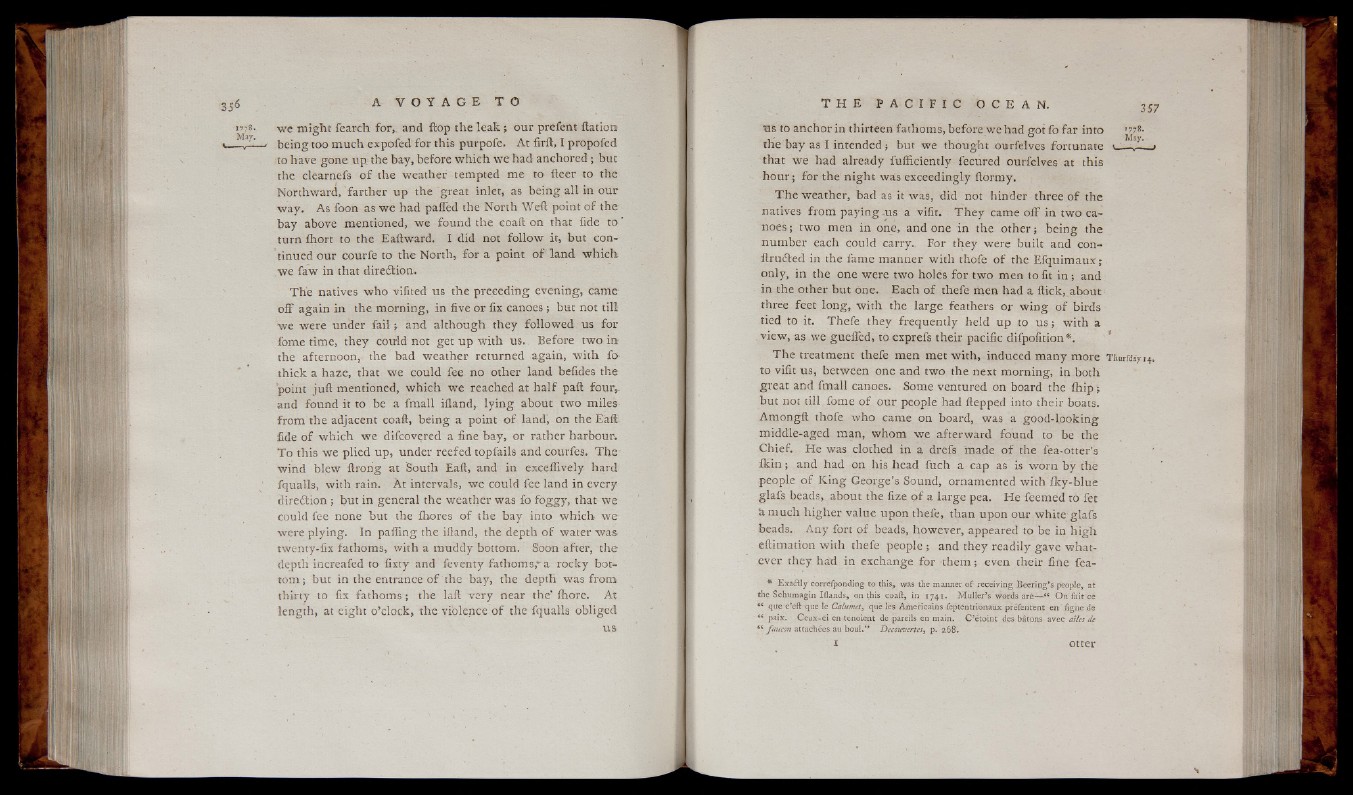
we migh t fearch for,, and flop the l e a k ; our prefent ftationt
being too much expofed for this purpofe. At firft, I propofed
to have gone up the bay, before w hich we had anchored ; but
the clearnefs o f the weather tempted me to fleer to the
Northward, farther up the great inlet, as being all in our
w a y . As foon as w e had paffed the North Weft point o f the
bay above mentioned, w e found the coaft on that fide to
turn fhort to the Eaftward. I did not fo llow it, but continued
our courfe to the North, fo r a point o f land w h ich
w e faw in that direction.
T h e natives who vifited us the preceding evening, came
o ff again in the morning, in five or fix canoes ; but not till
w e were under f a i l ; and a lthou gh they followed us fo r
fome time, they could not get up with us. Before two in-
the afternoon, the bad weather returned again, w ith fo-
th ick a haze, that w e could fee no other land befides the
point juft mentioned, which we reached at h a lf paft four,,
and found it to be a fmall ifland, ly in g about two miles
from the adjacent coaft, being a point o f land, on the Eaft
fide o f w hich we difcovered a fine bay, or rather harbour.
T o this w e plied up, under reefed topfails and courfes. T he
wind blew ftrong at South Eaft, and in exceflively hard
fqualls, with rain. At intervals, w e could fee land in every
direction ; but in general the weather was fo fo g g y , that w e
could fee none but the fhores o f the bay into w h ich w e
were p lying. In paffing the ifland, the depth o f water was
twenty-fix fathoms, with a muddy bottom. Soon after, the
depth increafed to fixty and feventy fathoms,*' a rocky bottom
; but in the entrance o f the bay, the depth was from
thirty to fix fathoms ; the laft ve ry near the' fhore. At
length, at eight o’clock, the violence o f the fqualls obliged
u s
tîs to anchor in thirteen fathoms, before we had got fo fa r into »778-
the bay as I intended ; but we thought ourfelves fortunate » — ■
that we had already fufficiently fecured ourfelves at this
hou r ; for the n igh t was exceedingly ftormy.
T h e weather, bad as it was, did not hinder three o f the
natives from paying .us a vifit. T h e y came o ff in two canoes
; two men in one, and one in the other ; b e in g the
number each could carry.. For they were built and con-
ftrudted in the fame manner with thofe o f the Efquimaux;
only, in the one were two holds for two men to fit in ; and
in the other but one. Each o f thefe men had a ftick, about
three feet long, w ith the large feathers or w in g o f birds
tied to it. Thefe they frequently held up to us ; with a
view, as we guefled, to exprefs their pacific difpoiition*.
T h e treatment thefe men met with , induced many more ThmCHy 14.
to vifit us, between one and two the next morning, in both
great and fmall canoes. Some ventured on board the ihip ;
but not till fome o f our people had ftepped into their boats.
Amongft thofe who came on board, was a good-looking
middle-aged man, whom we afterward found to be the
Chief. He was clothed in a drefs made o f the fea-otter’s
ikin ; and had on his head fuch a cap as is worn b y the
people o f K in g George’s Sound, ornamented with fky-blue
glafs beads, about the fize o f a large pea. He feemed to fet
U much highe r value upon thefe, than upon our white glafs
beads., Any fort o f beads, howevèr, appeared to be in high
eftimation with thefe people ; and they readily gave whatever
they hafl in exchange for them ; even their fine fea- ’
* Exa&ly correfponding to this, was the manner o f receiving Beering’ s people, at
the Schumagin Iflands, on this coaft, in 17 4 1 . Muller’ s words aré— <c On fait ce
ec que c’eft que le Calumet, que les Américains fepténtrionaux préfentent en ligne de
“ paix. Ceux-ci en tenoient de pareils en main. C ’étoint des batons avec aîles de
&c faucon attachées au boul.” Découvertes, p. 268.
i otter
h